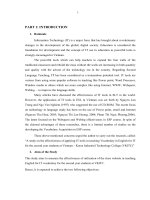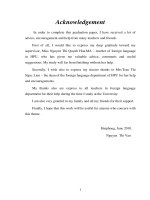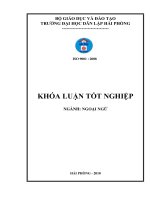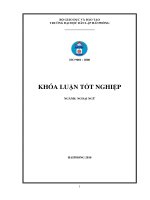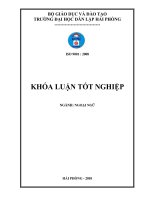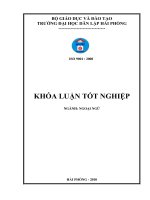Impact study on knowledge of rural women about preservation and processing
Bạn đang xem bản rút gọn của tài liệu. Xem và tải ngay bản đầy đủ của tài liệu tại đây (82.35 KB, 4 trang )
Int.J.Curr.Microbiol.App.Sci (2019) 8(1): 3212-3215
International Journal of Current Microbiology and Applied Sciences
ISSN: 2319-7706 Volume 8 Number 01 (2019)
Journal homepage:
Original Research Article
/>
Impact Study on Knowledge of Rural Women about
Preservation and Processing
Smita Bhatnagar1*, Poonam Choudhary2 and Dhriti Solanki2
1
2
S.M.S, (Home-Sc.), Chomu, India
College of Home-Science Udaipur (Raj.), India
*Corresponding author
ABSTRACT
Keywords
Knowledge of Rural
Women,
Preservation and
Processing
Article Info
Accepted:
14 December 2018
Available Online:
10 January 2019
The objective of the present study was to find out the knowledge of rural
women about homestead technologies in Chittorgarh district. The study
was conducted in Bhadesar and Bassi panchayat samities of Chittorgrarh
district of Rajasthan state. From each panchayat samiti, two villages where
the homestead technologies have been promoted by the KVK since last five
years were included in the study. The sample consisted of randomly
selected 100 rural women, 25 from each village. Personal interview method
was used for data collection. Mean per cent score were used for analysis of
data. The knowledge of the respondents about Preservation and processing
component revealed that majority of the respondents (66.94%) possessed
good knowledge.
Introduction
A rural women hold on three fold
responsibilities
of
home,
farm
and
management of livestock. In home she devotes
endless time in preparing food, washing
clothes, procuring fuel from forest, bringing
water, storing food grains, cleaning and
maintaining house, looking after children and
adults, participating in social and religious
ceremonies and the list is never ending. Beside
this, she does a lot of work in agriculture and
animal husbandry. Adding to the plight of
these, women use age old customary methods
for performing all these tasks which make
their work more drudgery ridden, tedious and
thorny.
Fruits and vegetables are important for the
well-being of an individual. They not only
provide essential vitamin and minerals but are
also rich in roughage or dietary fibers. In our
country, the diet of rural people is generally
deficient and lack in body-building foods such
as fruits and vegetables. This might be due to
widespread illiteracy and unawareness of
women about their functions and various food
preservation and processing technologies.
3212
Int.J.Curr.Microbiol.App.Sci (2019) 8(1): 3212-3215
Hence, knowledge of the rural women about
preservation and processing of food material
was assessed.
Materials and Methods
The study was conducted in Chittorgarh
district of Rajasthan state. The district has 11
panchayat samities out of these, two
panchayat samities namely Bhadesar and
Bassi were selected purposively where the
homestead technologies have been promoted
by the KVK since last five years (2009-2013).
Total four villages from two selected
panchayat samities were included in the study.
Sample for the study consisted of 100 rural
women, 25 from each village. Personal
interview method was used to collect the data
from the respondents. Mean percent score
were used for analysis of the data.
Results and Discussion
Background information of the respondents
More than 40 per cent respondents belonged
to the age group of 18-30 years and 38 per
cent were from 31-45 years of age. Majority
of the respondents (60%) were under upper
caste category.
Regarding education, 29 per cent respondents
were illiterate and 24 per cent were educated
up to middle level. Only 15 per cent
respondents were graduates. Farming was the
main family occupation of 89 per cent
respondents. All the respondents were
involved in some subsidiary occupations like
farm labor, business and service. Majority
(63%) belonged to nuclear family. More than
40 per cent respondents had small size family
consisting of up to 4 members. Majority of the
respondents (62%) were small and marginal
farmers. Majority of the respondents (75%)
were residing in pucca houses.
Knowledge of the respondents
Preservation and processing
about
Knowledge of the respondents about drudgery
reduction. Critical examination of the
knowledge score highlights that the
respondents possessed average knowledge
about Preservation and processing component
(66.94MPS). An in depth enquiry into
knowledge of the respondents in different
components was made to find out specific
deficiencies in knowledge so that necessary
efforts can be made to increase the knowledge
of the rural women about homestead
technologies.
Preservation and processing
Data presented in Table 1.1 reveal that
majority of the respondents knew about
nutrients found in soybean i.e. protein (67%),
calorie (81%) and fat (61%). Likewise, almost
all the rural women (94-100%) were aware
about the soya products viz. soya milk, flour,
curd and badi / papad. Regarding method of
preparing soya products, it was recorded that
majority of the respondents (77-85%) knew
about soya milk and soya flour however, none
of them was aware of method of preparing
soya curd. Processing of soybean before
consumption by boiling and soaking was
known to 42 and 7 per cent respondents,
respectively.
With regard to knowledge of the rural women
about preservation of fruits and vegetables,
Table 1.2 reveals that majority of the
respondents (77-89%) had knowledge about
various products that can be prepared by fruits
and vegetables like jam, jelly, squash, sauce,
chutney, pickle and murabba. Regarding
importance of preservation, 75 per cent
respondents knew that it ensures off season
availability of fruits and vegetables and 21 per
cent respondents knew that it adds variety to
meal.
3213
Int.J.Curr.Microbiol.App.Sci (2019) 8(1): 3212-3215
Table.1 Knowledge of the respondents about processing of soybean
n = 100
S. No.
1.
2.
3.
4.
Aspect
Nutrients found in soybean
a)
Protein
b)
Calorie
c)
Fat
Soya products
a)
Soya milk
b)
Soya flour
c)
Soya curd
d)
Soya badi / papad
Methods of preparing soya products
a)
Soya milk
b)
Soya flour
c)
Soya curd
Processing soybean before consumption
a)
By soaking
b)
By soiling
f/%
67
81
61
100
100
94
94
77
85
0
7
42
Table.2 Knowledge of the respondents about preservation of fruits and vegetables
n=100
S. No.
1.
2.
3.
4.
5.
6.
Aspect
Importance of preservation of fruits & vegetables food stuff
a)
Off season availability
b)
Adds variety to meal
c)
Make meal attractive
Preserved product from fruits and vegetables
a)
Jam
b)
Jelly
c)
Squash
d)
Sauce
e)
Chutney
f)
Pickle
g)
Murabba
Method of preparing following preserved product
a)
Mango pickle
b)
Squash
c)
Anola Murabba
Chemicals used for preservation of fruits and vegetable
a)
Sodium benzoate
b)
Potassium meta bi sulphite
Natural preservatives used in preservation of fruits and vegetable
a)
Oil
b)
Salt
c)
Sugar
d)
Vinegar
Consideration during storage of preserved products
a)
Use of sterilized jars,
b)
Store in cool and dry place
c)
Use of air tight container
3214
f/%
75
21
0
82
84
77
74
83
89
84
100
42
69
75
36
100
100
72
29
68
89
92
Int.J.Curr.Microbiol.App.Sci (2019) 8(1): 3212-3215
Cent percent respondents had knowledge
about method of preparing mango pickle, 69
per cent respondents knew about anola
murabba and more than 40 per cent
respondents knew about method of preparing
squash.
Mandowara (2005) also observed that the
majority of the respondents (53%) had
average knowledge about fruit and vegetable
preservation technologies, nearly 12 per cent
had good knowledge and 35 per cent
respondents had poor knowledge. Regarding
importance of preservation, 57 per cent
respondents could tell about availability of the
product round the year, prevent spoilage of
foods (36%), save money (20%) and adds
variety in diet (16%). Nearly 43 per cent
respondents knew about various methods of
preservation viz. pickling, chutny, murabba
etc. A majority of the respondents (70%)
knew about use of salt and oil as natural
preservatives while, 26 per cent knew about
chemical preservatives.
With respect to use of chemical preservatives,
70 per cent respondents had knowledge about
sodium benzoate whereas, only 36 per cent
respondents knew about potassium meta bi
sulphite. Cent percent respondents had
knowledge about salt and oil as a natural
preservative in fruits and vegetables likewise,
more than 70 per cent respondents had
knowledge about sugar and 29 per cent knew
about use of vinegar as a natural preservative
in fruits and vegetables. Majority of the
respondents had knowledge about points to be
considered during storage of preserved
products i.e. use of sterilized jars and airtight
container and storage in cool and dry place.
Based on the findings it could be concluded
that the respondents had good knowledge
about Preservation and processing.
References
Mandowara, D. 2005. Adoption of fruit and
vegetable preservation technologies by
rural women in selected villages in
Udaipur
district.
M.Sc.
Thesis
submitted
to
Maharana
Pratap
University
of
Agriculture
and
Technology, Udaipur, Rajasthan.
How to cite this article:
Smita Bhatnagar, Poonam Choudhary and Dhriti Solanki. 2019. Impact Study on Knowledge of
Rural Women about Preservation and Processing. Int.J.Curr.Microbiol.App.Sci. 8(01): 32123215. doi: />
3215

